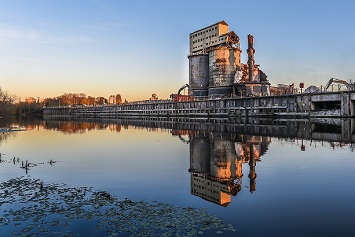The dictionary describes a brownfield as a former industrial or commercial site where future use is negatively impacted due to real or perceived environmental contamination. According to the EPA, there are more than 450,000 brownfields in the United States.
With so many designated brownfields across the country, companies that own property within designated brownfield areas or property that could receive a brownfield designation may want to consider applying for the designation to capitalize on property that otherwise can often be deemed unusable.
“The EPA’s Brownfields Program is designed to empower states, communities, and other stakeholders in economic redevelopment to work together in a timely manner to prevent, assess, safely clean up, and sustainably reuse brownfields,” according to the EPA. “Cleaning up and reinvesting in these properties increases local tax bases, facilitates job growth, utilizes existing infrastructure, takes development pressures off of undeveloped, open land, and both improves and protects the environment.”
Brownfield Designations
Brownfields’ designations come from local and state governments. Although specific procedures vary from state to state, there are basically two paths to receive a brownfield designation in order to receive federal and state aid to capitalize on the reuse of brownfield property.
For sites located within the boundaries of an area that already has a brownfield designation, requestors typically apply within their state by providing a request letter, a property ownership affidavit, and a legal description of the property.
For sites located outside designated brownfield areas—again, processes vary from state to state—the basic procedure is to request a brownfield designation in compliance with state-specific statutes.
Brownfield Funding
Grants serve as the foundation of the EPA’s Brownfields Program. They fund environmental assessment, cleanup, and job training activities. Specific EPA funding programs include:
- Brownfields Assessment Grants provide funding for brownfields inventories, planning, environmental assessments, and community outreach.
- Brownfields Revolving Loan Fund Grants provide funding to capitalize loans that are used to clean up brownfields.
- Brownfields Job Training Grants provide environmental training for residents of brownfield communities.
- Brownfields Cleanup Grants provide direct funding for cleanup activities at certain properties with planned green space, recreational, or other nonprofit uses.
- Brownfields Area-Wide Planning Grants provide funding to communities to research, plan, and develop implementation strategies for cleaning up and revitalizing a specific area affected by one or more brownfield sites.
Brownfield Redevelopment Challenges
Brownfield redevelopment offers unique real estate development challenges, including:
- Environmental liability concerns: Past and future liabilities associated with the property’s environmental history must be managed.
- Financial barriers: Lenders may be reluctant to provide funds for potentially impaired land, and cleanup costs could be projected to be more than the property’s value.
- Cleanup considerations: Redevelopment of brownfield properties generally takes longer than typical real estate development activities.
- Reuse planning: According to the EPA, often “[a] reuse plan based on community goals or sound economic and environmental information (e.g., market potential) may be lacking.”
Brownfield Redevelopment Process
So how do you successfully navigate the challenges of brownfield redevelopment? Here are the basic steps:
- Predevelopment
- Identify and refine a redevelopment idea by determining and assessing the potential reuses for the property.
- Conduct due diligence, which usually includes conducting property and environmental assessments, researching land and building titles for the property, and continuing communications with key stakeholders about the planned redevelopment for the highest and best use of the property.
- Secure access to the property from the property owner if the owner is not involved.
- Identify sources of funding, both public and private, which can include tax credits and abatements, grants, and federal brownfield funding programs.
- Securing the Deal
- Conduct contract negotiations to purchase the property.
- Secure financing for the purchase.
- Establish a remedial action plan by assessing remediation costs.
- Secure the property and formal commitment. Once formal closing documents are obtained, zoning changes should be pursued.
- Cleanup and Development
- Receive construction approvals, integrate and conduct cleanup and construction, and complete the redevelopment signified by the property’s sale or lease terms, including securing tenants.
- Complete cleanup activities based on the remedial action plan.
- Integrate cleanup and construction activities through streamlined processes to ensure construction delays do not cause significant increases in redevelopment costs.
- Property sale or lease: “Leasing begins when the construction schedule is determined,” according to the EPA. “After construction is complete, the property may or may not be sold. A commercial property may be sold or leased for long-term management. However, in most cases the property is leased first.”
- Completion and formal opening: Once construction is complete, ownership and leasing transactions are finalized, the property is occupied and operating, and the brownfield project becomes a successful redevelopment.
- Property Management
- Long-term operations and maintenance of remedial systems must be determined—for example, groundwater pump and treat systems require maintenance plans, engineering controls require regular inspection and maintenance, and institutional controls on any deed restrictions must be maintained.
Risk managers interested in learning more about brownfield development are encouraged to attend the 2021 National Brownfields Training Conference in Oklahoma City, Oklahoma, December 8–11, 2021.

